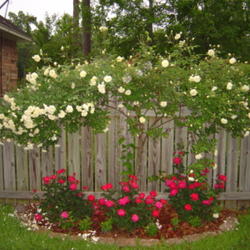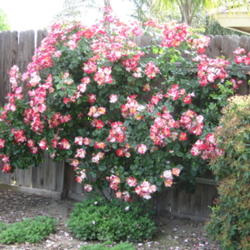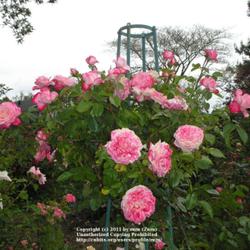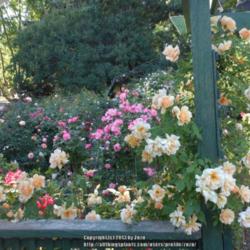Climbing roses with long and supple canes can be attached to an arbor or fence and allowed to cascade downward, creating a large ball of blossoms.
The climbers classified as climbing hybrid teas, climbing floribundas, and large-flower climbers tend to grow straight upward, however, and to produce blooms only at the top of each cane. This is a photo of a young climber I haven't begun to train yet. If I don't train it, the canes will continue to bloom only at the top as they grow, and there will be no leaves or blooms at the bottom. This is the condition known as "bare ankles" or "bare knees."
Some gardeners deal with this problem by planting shrub roses or other plants of various types in front of a climber to hide the “bare knees.”

Another solution is to keep a few canes shorter at all times, so that the flowering tips of those stems will close the gap.

The easiest and most popular solution, however, is to encourage horizontal growth. Climbing roses produce structural canes (the main canes) and lateral canes (the side shoots). The structural canes should be grown as horizontally as possible. The resulting increase in sunlight on the horizontal portion of the canes will stimulate the growth of more lateral shoots and, consequently, more blooms. There are several ways to accomplish this horizontal growth.

Pegging: Long arching canes are pulled down to the ground and secured there with garden staples. The arching canes will produce numerous short vertical shoots, each one of which will bloom.
Pillaring: Short climbers can be grown as pillar roses. The canes are wrapped loosely around a pillar or some other vertical support structure, offering many horizontal surfaces for new flowering shoots to sprout.

This one hasn't reached the top of the pillar yet, but I'll keep wrapping it until the pillar can't be seen any longer.

Espaliering: This can follow strictly formal patterns or more casual ones. The canes are attached horizontally to a fence or trellis. The use of wire or twine to secure the canes should be avoided. Both can damage bark or strangle the canes as they grow. Velcro garden tape is far preferable. It’s easy to use because it adheres to itself, so there’s no need to tie any knots or twist any wire. If necessary, it also can be removed, adjusted, or replaced with a longer piece of tape quickly and easily. The benefits of getting in and out as quickly as possible when working with thorny canes are obvious.
This is a photo of one of the main canes of a climbing hybrid tea. The main rose bush is out of sight, beyond the right-hand edge of the photo. I pulled the cane over to the left and secured it to a trellis. The cane is now producing flowering lateral shoots every few inches. If the cane had remained vertical, all or most of the blooms would be at the top of the cane, high above eye level.

Sometimes a combination of these training methods works best. The rose on the other side of this deck is attached to the lattice. When it gets taller, I’ll encourage the canes to spill over the deck railing, but I’ll also continue wrapping some of the canes around the post.

This is an example of a combination of horizontal attachment and pegging. The main part of this rose bush grows over the pergola on the right, but I wanted more color near my back door, so I pegged a couple of the low canes and I attached a couple of higher canes to the rain gutter above the door.

All of these illustrations follow simple designs, but if you have the time and energy, you could strive for something more impressive. This photo from Creative Commons (Attribution: Capodel) could serve as inspiration.
| Thread Title | Last Reply | Replies |
|---|---|---|
| Inspirational! by cliftoncat | Nov 19, 2015 3:33 PM | 1 |
| Untitled by donnaraehill | Jun 11, 2013 11:18 AM | 0 |
| Thank you for the ideas on training roses. by CarolineScott | May 27, 2013 7:18 PM | 20 |